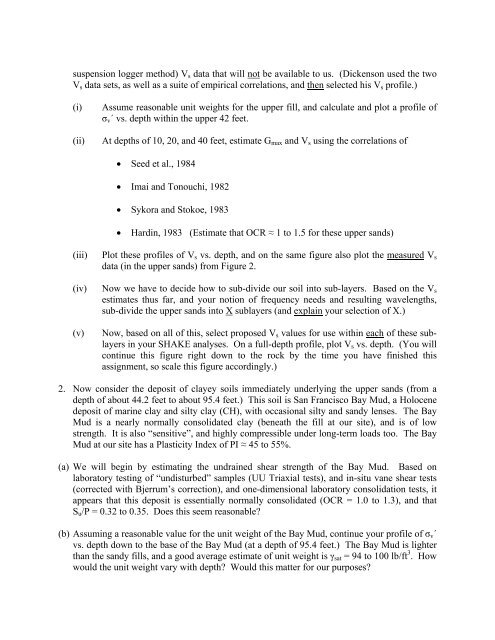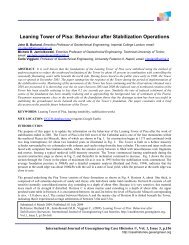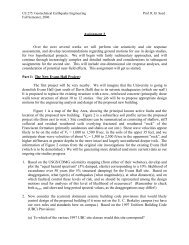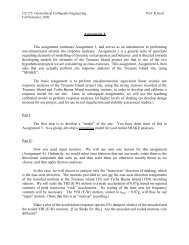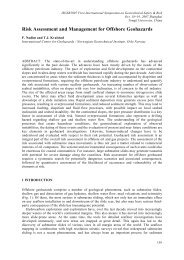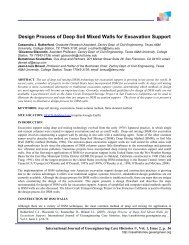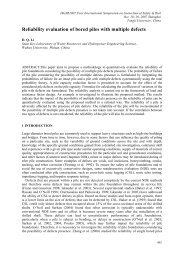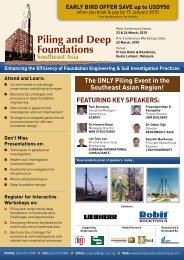Homework 3 (pdf) - Geotechnical Earthquake Engineering
Homework 3 (pdf) - Geotechnical Earthquake Engineering
Homework 3 (pdf) - Geotechnical Earthquake Engineering
You also want an ePaper? Increase the reach of your titles
YUMPU automatically turns print PDFs into web optimized ePapers that Google loves.
suspension logger method) V s data that will not be available to us. (Dickenson used the two<br />
V s data sets, as well as a suite of empirical correlations, and then selected his V s profile.)<br />
(i)<br />
(ii)<br />
Assume reasonable unit weights for the upper fill, and calculate and plot a profile of<br />
σ v΄ vs. depth within the upper 42 feet.<br />
At depths of 10, 20, and 40 feet, estimate G max and V s using the correlations of<br />
• Seed et al., 1984<br />
• Imai and Tonouchi, 1982<br />
• Sykora and Stokoe, 1983<br />
• Hardin, 1983 (Estimate that OCR ≈ 1 to 1.5 for these upper sands)<br />
(iii)<br />
(iv)<br />
(v)<br />
Plot these profiles of V s vs. depth, and on the same figure also plot the measured V s<br />
data (in the upper sands) from Figure 2.<br />
Now we have to decide how to sub-divide our soil into sub-layers. Based on the V s<br />
estimates thus far, and your notion of frequency needs and resulting wavelengths,<br />
sub-divide the upper sands into X sublayers (and explain your selection of X.)<br />
Now, based on all of this, select proposed V s values for use within each of these sublayers<br />
in your SHAKE analyses. On a full-depth profile, plot V s vs. depth. (You will<br />
continue this figure right down to the rock by the time you have finished this<br />
assignment, so scale this figure accordingly.)<br />
2. Now consider the deposit of clayey soils immediately underlying the upper sands (from a<br />
depth of about 44.2 feet to about 95.4 feet.) This soil is San Francisco Bay Mud, a Holocene<br />
deposit of marine clay and silty clay (CH), with occasional silty and sandy lenses. The Bay<br />
Mud is a nearly normally consolidated clay (beneath the fill at our site), and is of low<br />
strength. It is also “sensitive”, and highly compressible under long-term loads too. The Bay<br />
Mud at our site has a Plasticity Index of PI ≈ 45 to 55%.<br />
(a) We will begin by estimating the undrained shear strength of the Bay Mud. Based on<br />
laboratory testing of “undisturbed” samples (UU Triaxial tests), and in-situ vane shear tests<br />
(corrected with Bjerrum’s correction), and one-dimensional laboratory consolidation tests, it<br />
appears that this deposit is essentially normally consolidated (OCR = 1.0 to 1.3), and that<br />
S u /P = 0.32 to 0.35. Does this seem reasonable?<br />
(b) Assuming a reasonable value for the unit weight of the Bay Mud, continue your profile of σ v΄<br />
vs. depth down to the base of the Bay Mud (at a depth of 95.4 feet.) The Bay Mud is lighter<br />
than the sandy fills, and a good average estimate of unit weight is γ sat = 94 to 100 lb/ft 3 . How<br />
would the unit weight vary with depth? Would this matter for our purposes?


